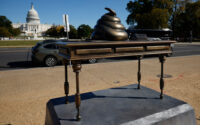Native American Curator Sues Chicago Blackhawks, Walker Art Center in Legal Trouble Over Breastfeeding Visitor, and More: Morning Links for May 21, 2024
To receive Morning Links in your inbox every weekday, sign up for our Breakfast with ARTnews newsletter.
THE HEADLINES
BLACKHAWK CONTROVERSY. Apsáalooke curator Nina Sanders is suing the Chicago Blackhawks hockey team foundation and CEO Danny Wirtz, for fraud, breach of contract, and violating the Gender Violence Act, reported CBS News. The Chicago Blackhawks had hired Sanders, a specialist in Native American art, as a cultural consultant and mediator amid growing opposition to the team’s name, which members of the Native community have found degrading and racist. Yet little went as planned, and Sanders alleges the Blackhawks executives reneged on an agreement to change the team name and logo, along with a list of unmet commitments, such as creating jobs for Native Americans, educating the organization on Black Hawk history, among others, according to The New York Times. Instead, Sanders said she was used to “pacify resistance,” from the Native community, in addition to being sexually harassed while on the job, along with one other woman in a separate incident. She said her formal reports of both cases went unheeded.
NURSING RIGHTS. In yet another litigation, a woman in Minneapolis has sued the Walker Art Center, because a staffer said she could not breastfeed her child in a gallery, and asked to escort her to another, closed room, reports The Art Newspaper. “My immediate mindset went to shame. And I didn’t want to make a fuss,” the woman, Megan Mzenga, told local KARE11 news. Her lawyer, Abou Amara, added that “women have the right to feed their children in public.” In fact, the museum’s website states that “parents are free to nurse children wherever feels most comfortable.”
THE DIGEST
Elvis Presley’s granddaughter, Riley Keough, has filed a legal complaint in a Tennessee court against Naussany Investements & Private Lending, whom she alleges is trying to sell Presley’s Graceland home and museum, based on “fraudulent” claims that its previous owner and Keough’s mother, Lisa Marie Presley, owed the company a $3.8 million loan and had used Graceland as collateral. On May 19 a public notice was posted locally, stating that Graceland would be auctioned at Shelby County Courthouse in Memphis this week. [The Guardian]
The artist Jonathan Yeo spoke to The Times about the scathing reactions to his official portrait of King Charles, why the red background, struggling with painting the King’s medals, and being most interested in the reaction of the Queen, Camilla – who approved. “No matter what you do with a picture, no matter how obvious you think the story you’re telling is, someone’s going to read something else into it,” said Yeo. [The Times]
Donald Trump’s campaign has threatened legal action against Sebastian Stan’s film, “The Apprentice,” about Trump’s years in real estate, calling the movie “garbage,” and “pure fiction.” “We will be filing a lawsuit to address the blatantly false assertions from these pretend filmmakers,” said Trump campaign spokesperson Steven Cheung. [Variety]
David Zwirner gallery is celebrating its 30th anniversary with the opening this week of their new Los Angeles space, featuring a group show of works by all of the artists on the gallery’s roster. They include new pieces by likes of Luc Tuymans, Stan Douglas, and more recent recruits, Elizabeth Peyton, Michael Armitage, and Emma McIntyre. [The Wrap]
The artist Lauren Halsey has unveiled renderings of an upcoming sculpture park she is installing in South Central Los Angeles. The temporary project titled “Sister Dreamer,” is similar to her rooftop installation shown at the Metropolitan Museum of Art in 2023, and is curated by Los Angeles Nomadic Division (LAND) co-founder Christine Y. Kim, with support from the Mellon Foundation’s Monuments Project. [Hypebeast]
THE KICKER
STAR ARTIST. Rachel Cusk writes a piercing short story for the Financial Times about a star visual artist, named G, as she grapples with the embedded constraints of fame, and a yearning for the wild freedom of her early days living in “one riotous, disorderly kingdom, bankrupt, continually menaced, but not yet invaded.” Cusk also deliciously gets into the painter’s process, which smacks of the way a writer might imagine a character’s development, bringing together the worlds of literature and visual arts. About a female figure she was painting, Cusk’s artist eventually “stopped being angry with the woman too and decided to love her. She lavished attention on her, which made her feel better, and when she realized that the woman … would actually be quite old by now she began carefully to break her down and return her to color and light and non-being.” Read on to experience G’s rise in the art world, the stifling male relationships formed along the way, and how the observant Cusk sees it.



